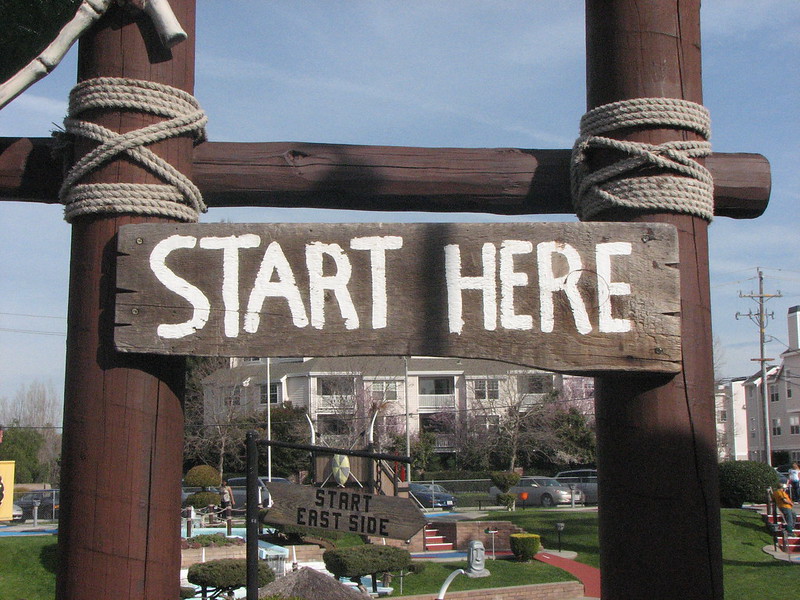Archive for the ‘Intellectual Intertia’ Category
Certainty or novelty – it’s your choice.
 When you follow the best practice, by definition your work is not new. New work is never done the same way twice. That’s why it’s called new.
When you follow the best practice, by definition your work is not new. New work is never done the same way twice. That’s why it’s called new.
Best practices are for old work. Usually, it’s work that was successful last time. But just as you can never step into the same stream twice, when you repeat a successful recipe it’s not the same recipe. Almost everything is different from last time. The economy is different, the competitors are different, the customers are in a different phase of their lives, the political climate is different, interest rates are different, laws are different, tariffs are different, the technology is different, and the people doing the work are different. Just because work was successful last time doesn’t mean that the old work done in a new context will be successful next time. The most important property of old work is the certainty that it will run out of gas.
When someone asks you to follow the best practice, they prioritize certainty over novelty. And because the context is different, that certainty is misplaced.
We have a funny relationship with certainty. At every turn, we try to increase certainty by doing what we did last time. But the only thing certain with that strategy is that it will run out of gas. Yet, frantically waving the flag of certainty, we continue to double down on what we did last time. When we demand certainty, we demand old work. As a company, you can have too much “certainty.”
When you flog the teams because they have too much uncertainty, you flog out all the novelty.
What if you start the design review with the question “What’s novel about this project?” And when the team says there’s nothing novel, what if you say “Well, go back to the drawing board and come back with some novelty.”? If you seek out novelty instead of squelching it, you’ll get more novelty. That’s a rule, though not limited to novelty.
A bias toward best practices is a bias toward old work. And the belief underpinning those biases is the belief that the Universe is static. And the one thing the Universe doesn’t like to be called is static. The Universe prides itself on its dynamic character and unpredictable nature. And the Universe isn’t above using karma to punish those who call it names.
“Stonecold certainty” by philwirks is licensed under CC BY-ND 2.0
What should we do next?
 Anonymous: What do you think we should do next?
Anonymous: What do you think we should do next?
Me: It depends. How did you get here?
Anonymous: Well, we’ve had great success improving on what we did last time.
Me: Well, then you’ll likely do that again.
Anonymous: Do you think we’ll be successful this time?
Me: It depends. If the performance/goodness has been flat over your last offerings, then no. When performance has been constant over the last several offerings it means your technology is mature and it’s time for a new one. Has performance been flat over the years?
Anon: Yes, but we’ve been successful with our tried-and-true recipe and the idea of creating a new technology is risky.
Me: All things have a half-life, including successful business models and long-in-the-tooth technologies, and your success has blinded you to the fact that yours are on life support. Developing a new technology isn’t risky. What’s risk is grasping tightly to a business model that’s out of gas.
Anon: That’s harsh.
Me: I prefer “truthful.”
Anon: So, we should start from scratch and create something altogether new?
Me: Heavens no. That would be a disaster. Figure out which elements are blocking new functionality and reinvent those. Hint: look for the system elements that haven’t changed in a dog’s age and that are shared by all your competitors.
Anon: So, I only have to reinvent several elements?
Me: Yes, but probably fewer than several. Probably just one.
Anon: What if we don’t do that?
Me: Over the next five years, you’ll be successful. And then in year six, the wheels will fall off.
Anon: Are you sure?
Me: No, they could fall off sooner.
Anon: How do you know it will go down like that?
Me: I’ve studied systems and technologies for more than three decades and I’ve made a lot of mistakes. Have you heard of The Voice of Technology?
Anon: No.
Me: Well, take a bite of this – The Voice of Technology. Kevin Kelly has talked about this stuff at great length. Have you read him?
Anon: No.
Me: Here’s a beauty from Kevin – What Technology Wants. How about S-curves?
Anon: Nope.
Me: Here’s a little primer – Beyond Dead Reckoning. How about Technology Forecasting?
Anon: Hmm. I don’t think so.
Me: Here’s something from Victor Fey, my teacher. He worked with Altshuller, the creator of TRIZ – Guided Technology Evolution. I’ve used this method to predict several industry-changing technologies.
Anon: Yikes! There’s a lot here. I’m overwhelmed.
Me: That’s good! Overwhelmed is a sign you realize there’s a lot you don’t know. You could be ready to become a student of the game.
Anon: But where do I start?
Me: I’d start Wardley Maps for situation analysis and LEANSTACK to figure out if customers will pay for your new offering.
Anon: With those two I’m good to go?
Me: Hell no!
Anon: What do you mean?
Me: There’s a whole body of work to learn about. Then you’ve got to build the organization, create the right mindset, select the right projects, train on the right tools, and run the projects.
Anon: That sounds like a lot of work.
Me: Well, you can always do what you did last time. END.
“he went that way matey” by jim.gifford is licensed under CC BY-SA 2.0
Just start.
 You’re not missing anything. It’s time to start.
You’re not missing anything. It’s time to start.
Afraid to fail? Start anyway.
Don’t have the experience? Well, you won’t be able to say that once you start.
Just start. It’s time.
Don’t have the money? Start small. And if that won’t work, start smaller.
Start small, but start.
Worried about what people might say? There’s only one way to know, so you might as well start.
You’re not an imposter. It’s time to start.
Waiting isn’t waiting, it’s a rationalization to block yourself from starting.
Here’s a rule: If you don’t start you can’t finish.
The only thing in the way of starting is starting.
The fear of success is the strongest stopper of starting. Be afraid of success, and start.
There’s never a good time to start, but there’s always a best time – now.
Worried about the negative consequences of starting? Be worried, and start.
Don’t think you have what it takes? The only way to know for sure is to start.
There’s no way around it. Starting starts with starting.
“Golfland start” by twid is licensed under CC BY-SA 2.0
The Dark Underbelly of Success
 Best practice – a tired recipe you recycle because you think the world is static.
Best practice – a tired recipe you recycle because you think the world is static.
Emergent practice – a new way to work created from whole cloth because the context is new.
Worst practice – a best practice applied to a world that has changed around you.
Novel practice– work that recognizes the world is a different place but is dismissed out-of-hand because everyone wants to live in the comfortable past.
Continuous improvement – when you try to put a shine on a tired, old process that worked ten years ago.
Discontinuous improvement – work that is disrespectful to the Status Quo and hurts people’s feelings.
Grow the core – when you do what you did in 2010 because you don’t know what else to do.
Obsolete your best work – when you do work that makes it clear to your customers that they should not have purchased your most successful product.
Reduce operating expense – what you do when you don’t know how to grow the top line and want to eliminate the flexibility to respond to an uncertain future.
Grow the top line – when you launch a new product that causes your customers to happily throw away the product they just bought from you.
A PowerPoint slide deck that defines your strategic plan – an electronic work product that distracts you from the reality of an ever-changing future.
A new product that is radically better than your last one – what you should create instead of a PowerPoint slide deck that defines your strategic plan.
MBA – a university degree that gives you a pedigree so companies hire you.
Ph.D. – a university degree that teaches you to learn, but takes too long.
Return On Investment (ROI) – a calculation that scuttles new work that would reinvent your business.
Imagination – thinking that will help you navigate an uncertain future, but is knee-capped by the ROI calculation.
Standard work – a process you used last time and will use next time because, again, you think the world is static.
Judgment – thinking that creates a whole new business trajectory to address an uncertain future but can get you fired if you use it.
A sustainable competitive advantage – a relic of a slow-moving world.
Continual change – the only way to deal with an ever-accelerating future.
Success – profits from work done by people who retired from your company some time ago.
Success – the thing that blocks you from working on the unproven.
Success – what pays the bills.
Success – what jeopardizes your ability to pay the bills in five years.
Success – why people think old practices are best practices.
Success – why new work is so difficult to do.
Success – why continuous improvement carries the day.
Success – why discontinuous improvement threatens.
Success – the mother of complacency.
“dark underbelly” by JoeBenjamin is licensed under CC BY-NC 2.0
The Innovation Mantra
 We have an immense distaste for uncertainty. And, as a result, we create for ourselves a radical and unskillful overestimation of our ability to control things. Our distaste of uncertainty is really a manifestation of our fear of death. When we experience and acknowledge uncertainty, it’s an oblique reminder that we will die. And that’s why talk ourselves into the belief we can control thing we really cannot. It’s a defense mechanism that creates distance between ourselves and from feeling our fear of death. And it’s the obliquity that makes it easier to overestimate our ability to control our environment. Without the obliquity, it’s clear we can’t control our environment, the very thing we wake up to every morning, and it’s clear we can’t control much. And if we can’t control much, we can’t control our aging and our ultimate end. And this is why we reject uncertainty at all costs.
We have an immense distaste for uncertainty. And, as a result, we create for ourselves a radical and unskillful overestimation of our ability to control things. Our distaste of uncertainty is really a manifestation of our fear of death. When we experience and acknowledge uncertainty, it’s an oblique reminder that we will die. And that’s why talk ourselves into the belief we can control thing we really cannot. It’s a defense mechanism that creates distance between ourselves and from feeling our fear of death. And it’s the obliquity that makes it easier to overestimate our ability to control our environment. Without the obliquity, it’s clear we can’t control our environment, the very thing we wake up to every morning, and it’s clear we can’t control much. And if we can’t control much, we can’t control our aging and our ultimate end. And this is why we reject uncertainty at all costs.
Predictable, controllable, repeatable, measurable – overt rejections of uncertainty. Six Sigma – Measure, Analyze, Improve, Control – overt rejection of uncertainty. Standard work – rejection of uncertainty. Don’t change the business model – a rejection of uncertainty. A rejection of novelty is a rejection of uncertainty. And that’s why we don’t like novelty. It scares us deeply. And it scares us because it reminds us that everything changes, including our skin, joints, and hairline. And that’s why it’s so challenging to do innovation.
Innovation reminds us of our death and that’s why it’s difficult? Really? Yes.
Six Sigma is comforting because its programmatic illusion of control lets us forget about our death? Yes.
The aging business model reminds us of our death and that’s why we won’t let it go? Yes.
That’s crazy! Yes, but at the deepest level, I think it’s true.
I understand if you disagree with my rationale. And I understand if you think my thinking is morbid. If that’s the case, I suggest you write down why you think it’s so incredibly difficult to create a new business model, to do novel work, or to obsolete your best work. I’ll stop for a minute to give you time to grab a pen and paper. Okay, now put your pen to paper and write down why doing innovation (doing novel work) is so difficult. Now, ask yourself why that is. And do that three more times. Where did you end up? What’s the fundamental reason why doing new work (and the uncertainty that comes with it) is so difficult to do?
To be clear, I’m not advocating that you tell everyone that innovation is difficult because it reminds them that they’ll die. I explained my rationale to give you an idea of the magnitude of the level of fear around uncertainty so that, when someone is scared to death of novelty, you might help them navigate their fear.
Trying something new doesn’t invalidate what you did over the last decade to grow your business, nor will it replace it immediately, if it all. Maybe the new work will add to what you’ve done over the last decade. Maybe the new work will amplify what’s made you successful. Maybe the new work will slowly and effectively migrate your business to greener pastures. And maybe it won’t work at all. Or, maybe your customers will make it work and bury you and your business.
With innovation, start small. That way the threat is smaller. Run small experiments and share the results, especially the bad results. That way you demonstrate that unanticipated results don’t kill you and, when you share them, you demonstrate that you’re not afraid of uncertainty. Try many things in parallel to demonstrate that it’s okay that everything doesn’t turn out well and you’re okay with it. And when someone asks what you’ll do next, tell them “I don’t know because it depends on how the next experiment turns out.”
When you’re asked when you’ll be done with an innovation project, tell them “I don’t know because the work has never been done before.” And if they say you must give them a completion date, tell them “If you must have a completion date, you do the project.”
When you’re running multiple experiments in parallel and you’re asked what you’ll do next, tell them you’ll do “more of what works and less of what doesn’t.” And if they say “that’s not acceptable”, then tell them “Well, then you run the project.”
We don’t have nearly as much control as our minds want to us believe, but that’s okay as long as we behave like we know it’s true. Uncertainty is uncomfortable, but that’s not a bad thing. In fact, I think it’s a good thing.
If people aren’t afraid, there can be no uncertainty. And if there’s no uncertainty, there can be no novelty. And if there’s no novelty, there can be no innovation. If people aren’t afraid, you’re doing it wrong.
As a leader, tell them you’re afraid but you’re going to do it anyway.
As a leader, tell your team that it’s natural to be afraid and their fear is a leading indicator of innovation.
As a leader, tell them there’s one thing you’re certain about – that innovation is uncertain.
And when things get difficult, repeat the Innovation Mantra: Be afraid and do it anyway.
“Mantra” by j / f / photos is licensed under CC BY-ND 2.0
Technical Risk, Market Risk, and Emotional Risk
Technical risk – Will it work?
Market risk – Will they buy it?
Emotional risk – Will people laugh at your crazy idea?
Technical risk – Test it in the lab.
Market risk – Test it with the customer.
Emotional risk – Try it with a friend.
Technical risk – Define the right test.
Market risk – Define the right customer.
Emotional risk – Define the right friend.
Technical risk – Define the minimum acceptable performance criteria.
Market risk – Define the minimum acceptable response from the customer.
Emotional risk – Define the minimum acceptable criticism from your friend.
Technical risk – Can you manufacture it?
Market risk – Can you sell it?
Emotional risk – Can you act on your crazy idea?
Technical risk – How sure are you that you can manufacture it?
Market risk – How sure are you that you can sell it?
Emotional risk – How sure are you that you can act on your crazy idea?
Technical risk – When the VP says it can’t be manufactured, what do you do?
Market risk – When the VP says it can’t be sold, what do you do?
Emotional risk – When the VP says your idea is too crazy, what do you do?
Technical risk – When you knew the technical risk was too high, what did you do?
Market risk – When you knew the market risk was too high, what did you do?
Emotional risk – When you knew someone’s emotional risk was going to be too high, what did you do?
Technical risk – Can you teach others to reduce technical risk? How about increasing it?
Market risk – Can you teach others to reduce technical risk? How about increasing it?
Emotional risk – Can you teach others to reduce emotional risk? How about increasing it?
Technical risk – What does it look like when technical risk is too low? And the consequences?
Market risk – What does it look like when technical risk is too low? And the consequences?
Emotional risk – What does it look like when emotional risk is too low? And the consequences?
We are most aware of technical risk and spend most of our time trying to reduce it. We have the mindset and toolset to reduce it. We know how to do it. But we were not taught to recognize when technical risk is too low. And if we do recognize it’s too low, we don’t know how to articulate the negative consequences. With all this said, market risk is far more dangerous.
We’re unfamiliar with the toolset and mindset to reduce market risk. Where we can change the design, run the test, and reduce technical risk, market risk is not like that. It’s difficult to understand what drives the customers’ buying decision and it’s difficult to directly (and quickly) change their buying decision. In short, it’s difficult to know what to change so they make a different buying decision. And if they don’t buy, you don’t sell. And that’s a big problem. With that said, emotional risk is far more debilitating.
When a culture creates high emotional risk, people keep their best ideas to themselves. They don’t want to be laughed at or ridiculed, so their best ideas don’t see the light of day. The result is a collection of wonderful ideas known only to the underground Trust Network. A culture that creates high emotional risk has insufficient technical and market risk because everyone is afraid of the consequences of doing something new and different. The result – the company with high emotional risk follows the same old script and does what it did last time. And this works well, right up until it doesn’t.
Here’s a three-pronged approach that may help.
- Continue to reduce technical risk.
- Learn to reduce market risk early in a project.
- And behave in a way that reduces emotional risk so you’ll have the opportunity to reduce technical and market risk.
Image credit — Shan Sheehan
What You Don’t Have
 If you have more features, I will beat you with fewer.
If you have more features, I will beat you with fewer.
If you have a broad product line, I will beat you with my singular product.
If your solution is big, mine will beat you with small.
If you sell across the globe, I will sell only in the most important market and beat you.
If you sell to many customers, I will provide a better service to your best customer and beat you.
If your new projects must generate $10 million per year, I will beat you with $1 million projects.
If you are slow, I will beat you with fast.
If you use short term thinking, I will beat you with long term thinking.
If you think in the long term, I will think in the short term and beat you.
If you sell a standardized product, I will beat you with customization.
If you are successful, I will beat you with my hunger.
If you try to do less, I will beat you with far less.
If you do what you did last time, I will beat you with novelty.
If you want to be big, I will be a small company and beat you.
I will beat you with what you don’t have.
Then, I will obsolete my best work with what I don’t have.
Your success creates inertia. Your competitors know what you’re good at and know you’ll do everything you can to maintain your trajectory. No changes, just more of what worked. And they will use your inertia. They will start small and sell to the lowest end of the market. Then they’ll grow that segment and go up-scale. You will think they are silly and dismiss them. And then they will take your best customers and beat you.
If you want to know how your competitors will beat you, think of your strength as a weakness. Here’s a thought experiment to explain. If your success is based on fast, turn speed into weakness and constrain out the speed. Declare that your new product must be slow. Then, create a growth plan based on slow. That growth plan is how your competitors will beat you.
Your growth won’t come from what you have, it will come from what you don’t have.
It’s time to create your anti-product.
Are you doing what you did last time?
If there’s no discomfort, there’s no novelty.
When there’s no novelty, it means you did what you did last time.
When you do what you did last time, you don’t grow.
When you do what you did last time, there’s no learning.
When you do what you did last time, opportunity cost eats you.
If there’s no discomfort, you’re not trying hard enough.
If there’s no disagreement, critical thought is in short supply.
When critical thought is in short supply, new ideas never see the light of day.
When new ideas never see the light of day, you end up doing what you did last time.
When you do what you did last time, your best people leave.
When you do what you did last time, your commute into work feels longer than it is.
When you do what you did last time, you’re in a race to the bottom.
If there’s no disagreement, you’re playing a dangerous game.
If there’s no discretionary work, crazy ideas never grow into something more.
When crazy ideas remain just crazy ideas, new design space remains too risky.
When new design space remains too risky, all you can do is what you did last time.
When you do what you did last time, managers rule.
When you do what you did last time, there is no progress.
When you do what you did last time, great talent won’t accept your job offers.
If there’s no discretionary work, you’re in trouble.
We do what we did last time because it worked.
We do what we did last time because we made lots of money.
We do what we did last time because it’s efficient.
We do what we did last time because it feels good.
We do what we did last time because we think we know what we’ll get.
We do what we did last time because that’s what we do.
Doing what we did last time works well, right up until it doesn’t.
When you find yourself doing what you did last time, do something else.
Image credit — Matt Deavenport
The Power of Prototypes
 A prototype moves us from “That’s not possible.” to “Hey, watch this!”
A prototype moves us from “That’s not possible.” to “Hey, watch this!”
A prototype moves us from “We don’t do it that way.” to “Well, we do now.”
A prototype moves us from “That’s impossible.” to “As it turns out, it was only almost impossible.”
A prototype turns naysayers into enemies and profits.
A prototype moves us from an argument to a new product development project.
A prototype turns analysis-paralysis into progress.
A prototype turns a skeptical VP into a vicious advocate.
A prototype turns a pet project into top-line growth.
A prototype turns disbelievers into originators of the idea.
A prototype can turn a Digital Strategy into customer value.
A prototype can turn an uncomfortable Board of Directors meeting into a pizza party.
A prototype can save a CEO’s ass.
A prototype can be too early, but mostly they’re too late.
If the wheels fall off your first prototype, you’re doing it right.
If your prototype doesn’t dismantle the Status-Quo, you built the wrong prototype.
A good prototype violates your business model.
A prototype doesn’t care if you see it for what it is because it knows everyone else will.
A prototype turns “I don’t believe you.” into “You don’t have to.”
When you’re told “Don’t make that prototype.” you’re onto something.
A prototype eats not-invented-here for breakfast.
A prototype can overpower the staunchest critic, even the VP flavor.
A prototype moves us from “You don’t know what you’re talking about.” to “Oh, yes I do.”
If the wheels fall off your second prototype, keep going.
A prototype is objective evidence you’re trying to make a difference.
You can argue with a prototype, but you’ll lose.
If there’s a mismatch between the theory and the prototype, believe the prototype.
A prototype doesn’t have to do everything, but it must do one important thing for the first time.
A prototype must be real, but it doesn’t have to be really real.
If your prototype obsoletes your best product, congratulations.
A prototype turns political posturing into reluctant compliance and profits.
A prototype turns “What the hell are you talking about?” into “This.”
A good prototype bestows privilege on the prototyper.
A prototype can beat a CEO in an arm-wrestling match.
A prototype doesn’t care if you like it. It only cares about creating customer value.
If there’s an argument between a well-stated theory and a well-functioning prototype, it’s pretty clear which camp will refine their theory to line up with what they just saw with their own eyes.
A prototype knows it has every right to tell the critics to “Kiss my ass.” but it knows it doesn’t have to.
You can argue with a prototype, but shouldn’t.
A prototype changes thinking without asking for consent.
Image credit — Pedro Ribeiro Simões
Words To Live By
 What people think about you is none of your business.
What people think about you is none of your business.
If you’re afraid to be wrong, you shouldn’t be setting direction.
Think the better of people, as they’ll be better for it.
When you find yourself striving, pull the emergency brake and figure out how to start thriving.
If you want the credit, you don’t want to make a difference.
If you’re afraid to use your best judgment, find a mentor.
Family first, no exceptions.
When you hold a mirror to the organization, you demonstrate that you care.
If you want to grow people and you invest less than 30% of your time, you don’t want to grow them.
When someone gives you an arbitrary completion date, they don’t know what they’re doing.
When the Vice President wants to argue with the physics, let them.
When all else fails, use your best judgment.
If it’s not okay to tell the truth, work for someone else.
The best way to make money is not the best way to live.
When someone yells at you, that says everything about them and nothing about you.
Trust is a result. Think about that.
When you ask for the impossible, all the answers will be irrational.
No one can diminish you without your consent.
If you don’t have what you want, why not try to want what you have?
When you want to control things, you limit the growth of everyone else.
People can tell when you’re telling the truth, so tell them.
If you find yourself watching the clock, find yourself another place to work.
When someone does a great job, tell them.
If you have to choose between employment and enjoyment, choose the latter.
If you’re focused on cost reduction, you’re in a race to the bottom.
The best way to help people grow is to let them do it wrong (safely).
When you hold up a mirror to the organization, no one will believe what they see.
If you’re not growing your replacement, what are you doing?
If you’re not listening, you’re not learning.
When someone asks for help, help them.
If you think you know the right answer, you’re the problem.
When someone wants to try something new, help them.
Whatever the situation, tell the truth, and love everyone.
Image credit — John Fife
When it’s Time to Make a Difference
When it’s time to make meaningful change, there’s no time for consensus.
When the worn path of success must be violated, use a small team.
When it’s time for new thinking, create an unreasonable deadline, and get out of the way.
The best people don’t want the credit, they want to be stretched just short of their breaking point.
When company leadership wants you to build consensus before moving forward, they don’t think the problem is all that important or they don’t trust you.
When it’s time to make unrealistic progress, it’s time for fierce decision making.
When there’s no time for consensus, people’s feelings will be hurt. But there’s no time for that either.
When you’re pissed off because there’s been no progress for three years, do it yourself.
When it’s time to make a difference, permission is not required. Make a difference.
The best people must be given the responsibility to use their judgment.
When it’s time to break the rules, break them.
When the wheels fall off, regardless of the consequences, put them back on.
When you turn no into yes and catch hell for violating protocol, you’re working for the wrong company.
When everyone else has failed, it’s time to use your discretion and do as you see fit.
When you ask the team to make rain and they balk, you didn’t build the right team.
When it’s important and everyone’s afraid of getting it wrong, do it yourself and give them the credit.
The best people crave ridiculous challenges.
When the work must be different, create an environment that demands the team acts differently.
When it’s time for magic, keep the scope tight and the timeline tighter.
When the situation is dire and you use your discretion, to hell with anyone who has a problem with it.
When it’s time to pull a rabbit out of the hat, you get to decide what gets done and your special team member gets to decide how to go about it. Oh, and you also get to set an unreasonable time constraint.
When it’s important, to hell with efficiency. All that matters is effectiveness.
The best people want you to push them to the limit.
When you think you might get fired for making a difference, why the hell would you want to work for a company like that?
When it’s time to disrespect the successful business model, it’s time to create harsh conditions that leave the team no alternative.
The best people want to live where they want to live and do impossible work.
Image credit — Bernard Spragg. Nz



 Mike Shipulski
Mike Shipulski